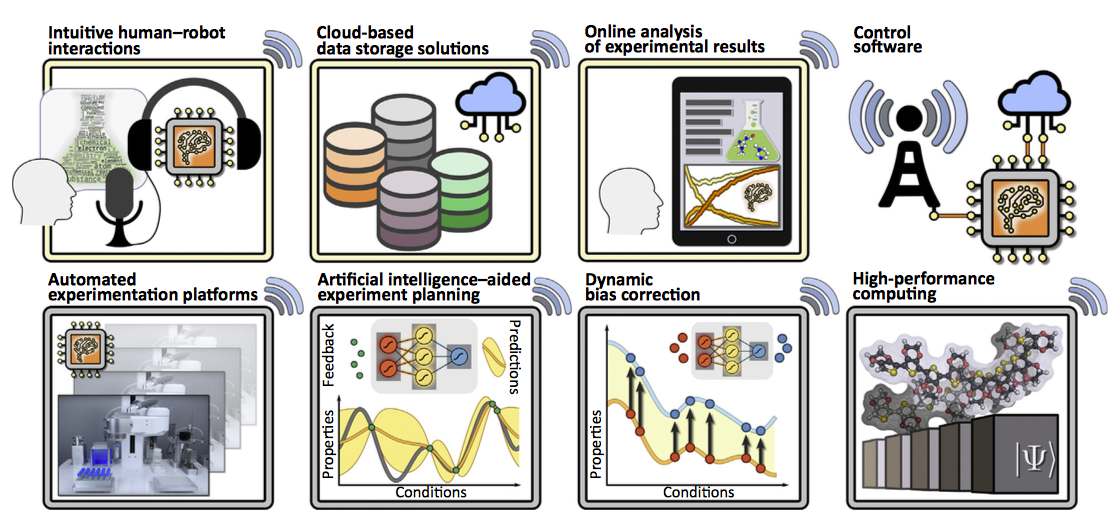Communications of the ACM
Letting the Laboratory Drive

University of Toronto chemistry professor Alan Aspuru-Guzik says self-driving laboratories could speed the discovery of new drugs and materials at a vastly reduced cost.
Credit: University of Toronto
With hasty steps, Alan Aspuru-Guzik arrives for the interview. "Let's start," he says, barely having taken his place in his chair. He has no time to lose, not in the interview and not in his scientific research to discover new materials. "We live in the era of advanced materials. We as a species are big enough to change the climate, but I believe we are also big enough to stop changing the climate by inventing and using advanced materials."
Aspuru-Guzik is a professor of chemistry and of computer science at the University of Toronto. He moved to Canada last year after having spent 18 years in the U.S., first at the University of California, Berkeley and, since 2006, at Harvard University. Originally from Mexico City, Aspuru-Guzik's distaste for the immigration policies of U.S. President Donald Trump is partly what motivated him to move with his family from the U.S. to Canada.
I met with Aspuru-Guzik a couple of hours before he gave his keynote lecture at the American Association for the Advancement of Science (AAAS) 2019 Annual Meeting in Washington D.C., on the topic 'Materials for the future: Self-driving laboratories'.
Why do we need self-driving laboratories?
A self-driving laboratory helps chemists to discover new materials much more rapidly. There are 1082 atoms in the visible universe; out of this, you can make 1060 to 10180 medium-size molecules. Many of the solutions of our 21st century problems lie there; solutions for better drugs, and solutions for advanced materials that can be used in sustainable energy applications. Think of materials for harvesting solar energy or wind power, and materials for solar fuels and batteries. However, most molecules in that vast chemical space are useless; only a limited amount of them are promising. At present, it takes 10 years and $10 million to make a new material; that's too slow. Our first goal is to gain a factor of 10: around 2025, we want to be able to discover a new material in one year at the cost of only $1 million.
How does a 'self-driving laboratory' work?
Let's first make a distinction between automation and autonomy. Chemistry has used automation in experiments already for a couple of decades, but autonomy is new. A self-driving laboratory is a kind of robot scientist that uses sensors to become aware of its environment, and artificial intelligence (AI) to autonomously make decisions. In our vision, the self-driving laboratory has seven components: intuitive human-robot interactions using natural language, cloud-based data storage solutions, online analysis of experimental results, automated experimentation platforms, AI-aided experimental planning, dynamic bias correction, and high performance computing. Looking at the science of discovering new materials, we try to introduce AI in every step of the discovery of new materials. The self-driving lab can generate the most promising molecules to start the experiment with; next, based on the molecules it has tested, it can come up with the most promising next test molecules. It can also optimize experimental conditions: make it a bit warmer or cooler, use a bit more or a bit less solvent, a bit more or a bit less catalyst. When you digitize every part of the experiment, AI can be used in all these parts.

for experiment planning,device scheduling, data analysis, and researcher communication.
Credit: Next-Generation Experimentation with Self-Driving Laboratories, Trends in Chemistry, http://bit.ly/2GFqX8F
What happens with the human intuition of the experimenter?
Humans have some intuition, but they are also very biased. AI helps us to get rid of the human bias. Sometimes a lack of knowledge helps the discovery. It's like little kids discovering new things; you lose a pen somewhere, can't find it yourself, and your child discovers it in a place that you never imagined. The AI of our self-driving lab is like this little kid.
Will AI replace the human altogether from the scientific experiment?
So far, AI has been only very good at constrained tasks: playing chess, Starcraft, or go. I am very suspicious of the ultimate fully autonomous robot scientist. In my vision, the scientist of the future is more like the person in a self-driving car: the car is doing a lot of the work, but the person is still telling the car where to go, when, and what for. I believe that the scientist of the future will be a cyborg: human and robot melded together."
Which results have you achieved with your self-driving laboratory?
Right now, we are focusing on the process of discovery, not yet on the discovery itself. For example, our self-driving lab has optimized certain parameters overnight, that took humans a few months to do. We have shown that the self-driving lab uses far fewer experiments to find a promising material for organic solar cells than the traditionally used high-throughput screening. In mid-February, our new robot arrived in Toronto; I can't wait to have this one up and running. We want to digitize the field. We are the McDonald's of organic chemistry. Therefore, some people think we are the raw type of chemists. Well, I feel good to be part of this rebellion."
Bennie Mols is a science and technology writer based in Amsterdam, the Netherlands.
No entries found